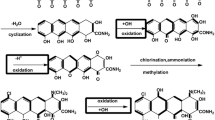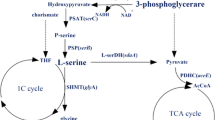Abstract
The aspartate pathway of Streptomyces clavuligerus is an important primary metabolic pathway which provides substrates for β-lactam synthesis. In this study, the hom gene which encodes homoserine dehydrogenase was cloned from the cephamycin C producer S. clavuligerus NRRL 3585 and characterized. The fully sequenced open reading frame encodes 433 amino acids with a deduced M r of 44.9 kDa. The gene was heterologously expressed in the auxotroph mutant Escherichia coli CGSC 5075 and the recombinant protein was purified. The cloned gene was used to construct a plasmid containing a hom disruption cassette which was then transformed into S. clavuligerus. A hom mutant of S. clavuligerus was obtained by insertional inactivation via double crossover, and the effect of hom gene disruption on cephamycin C yield was investigated by comparing antibiotic levels in culture broths of this mutant and in the parental strain. Disruption of hom gene resulted in up to 4.3-fold and twofold increases in intracellular free l-lysine concentration and specific cephamycin C production, respectively, during stationary phase in chemically defined medium.




Similar content being viewed by others
References
Aharonowitz Y, Demain AL (1978) Carbon catabolite regulation of cephalosporin production in Streptomyces clavuligerus. Antimicrob Agents Chemother 14:159–164
Archer JA, Solow-Cordero DE, Sinskey AJ (1991) A C-terminal deletion in Corynebacterium glutamicum homoserine dehydrogenase abolishes allosteric inhibition by l-threonine. Gene 107:53–59
Betancort Rodriguez JR, Garcia Reina G, Santana Rodriguez JJ (1997) Determination of free amino acids in microalgae by high-performance liquid chromatography using pre-column fluorescence derivatization. Biomed Chromatogr 11:335–336
Bradford MM (1976) A rapid and sensitive method for the quantitation of microgram quantities of protein utilizing the principle of protein-dye binding. Anal Biochem 72:248–254
Clepet C, Borne F, Baird C, Patte JC, Cami B (1992), Isolation, organization and expression of Pseudomonas aeruginosa threonine genes. Mol Microbiol 6:3109–3119
Cohen GN, Saint-Girons I (1987) Biosynthesis of threonine, lysine and methionine. In: E. coli and S. typhimurium: cellular and molecular biology. ASM, Washington DC, pp 429–444
Fernandez M, Cuadrado Y, Recio E, Aparicio JF, Martin JF (2002) Characterization of the hom-thrC-thrB cluster in aminoethoxyvinylglycine-producing Streptomyces sp. NRRL 5331. Microbiology 148:1413–1420
Fujita Y, Ukena E, Iefuji H, Giga-Hama Y, Takegawa K (2006) Homocysteine accumulation causes a defect in purine biosynthesis: further characterization of Schizosaccharomyces pombe methionine auxotrophs. Microbiology 152:397–404
Gehring AM, Wang ST, Kearns DB, Storer NY, Losick R (2004) Novel genes that influence development in Streptomyces coelicolor. J Bacteriol 86:3570–3577
Keiser T, Bibb MJ, Buttner MJ, Chater KF, Hopwood DA (2000) Practical Streptomyces genetics, The John Innes Foundation, Norwich
Kern BA, Hendlin D, Inamine E (1980) l-lysine-ɛ-aminotransferase involved in cephamycin C synthesis in Streptomyces lactamdurans. Antimicrob Agents Chemother 17:679–685
Khetan A, Malmberg LH, Kyung YS, Sherman DH, Hu WS (1999) Precursor and cofactor as a check valve for cephamycin biosynthesis in Streptomyces clavuligerus. Biotechnol Prog 15:1020–1027
Laemmli UK (1970) Cleavage of structural proteins during the assembly of the head of bacteriophage T4. Nature 227:680–685
Madsen SM, Albrechtsen B, Hansen EB, Israelsen H (1996) Cloning and transcriptional analysis of two threonine biosynthetic genes from Lactococcus lactis MG1614. J Bacteriol 178:3689–3694
Malmberg LH, Hu WS, Sherman DH (1993) Precursor flux control through targeted chromosomal insertion of the lysine epsilon-aminotransferase (lat) gene in cephamycin C biosynthesis. J Bacteriol 175:6916–6924
Malumbres M, Mateos LM, Guerrero C, Martin JF (1995) Molecular cloning of the hom-thrC-thrB cluster from Bacillus sp. ULM1: expression of the thrC gene in Escherichia coli and corynebacteria, and evolutionary relationships of the threonine genes. Folia Microbiol (Praha) 40:595–606
Marchenko G, Tsygankov Y (1992) Genes for threonine biosynthesis in Methylobacillus flagellatum. In: Abstract in proceedings of the 7th international symposium on microbial growth on C1, B79
Marchenko GN, Marchenko DN, Tsygankov YD, Chistoserdov AY (1999) Organization of threonine biosynthesis genes from the obligate methylotroph Methylobacillus flagellatus. Microbiology 145:3273–3282
Mendelovitz S, Aharonowitz Y (1982) Regulation of cephamycin C synthesis, aspartokinase, dihydrodipicolinic acid synthetase and homoserine dehydrogenase by aspartic acid family amino acids in Streptomyces clavuligerus. Antimicrob Agents Chemother 21:74–84
Mendelovitz S, Aharonowitz Y (1983) β-lactam antibiotic production by Streptomyces clavuligerus mutants impaired in regulation of aspartokinase. J Gen Microbiol 129:2063–2069
Motoyama H, Maki K, Anazawa H, Ishino S, Teshiba S (1994) Cloning and nucleotide sequences of the homoserine dehydrogenase genes (hom) and the threonine synthase genes (thrC) of the gram-negative obligate methylotroph Methylobacillus glycogens. Appl Environ Microbiol 60:11–119
Parsot C, Cohen GN (1988) Cloning and nucleotide sequence of the Bacillus subtilis hom gene coding for homoserine dehydrogenase. J Biol Chem 263:14654–14660
Peoples OP, Liebl W, Bodis M, Maeng PJ, Folletie JT, Archer JA, Sinskey AJ (1988) Nucleotide sequence and structural analysis of the Corynebacterium glutamicum hom-thrB operon. Mol Microbiol 2:63–72
Pridmore RD (1987) New and versatile cloning vectors with kanamycin-resistance marker. Gene 56:309–312
Sambrook J, Fritsch EF, Maniatis T (1989) Molecular cloning: a laboratory manual, 2nd edn. Cold Spring Harbour Laboratory Press, New York
Shio I, Miyajima R (1969) Concerted inhibition and its reversal by end products of aspartate kinase in Brevibacterium flavum. J Biochem 65:849–859
Thykaer J, Nielsen J (2003) Metabolic engineering of β-lactam production. Metab Eng 5:56–69
Tunca S, Yılmaz EI, Piret J, Liras P, Özcengiz G (2004) Cloning, characterization and heterologous expression of the aspartokinase and aspartate semialdehyde dehydrogenase genes of cephamycin C-producer Streptomyces clavuligerus. Res Microbiol 155:525–534
Wright F, Bibb MJ (1992) Codon usage in the G−C-rich Streptomyces genome. Gene 113:55–65
Acknowledgments
This study was supported by the Scientific and Technical Research Council of Turkey (SBAG 2753). We thank Gulveren Taskin for her technical assistance in amino acid analysis.
Author information
Authors and Affiliations
Corresponding author
Rights and permissions
About this article
Cite this article
Yılmaz, E.I., Çaydasi, A.K. & Özcengiz, G. Targeted disruption of homoserine dehydrogenase gene and its effect on cephamycin C production in Streptomyces clavuligerus . J Ind Microbiol Biotechnol 35, 1–7 (2008). https://doi.org/10.1007/s10295-007-0259-8
Received:
Accepted:
Published:
Issue Date:
DOI: https://doi.org/10.1007/s10295-007-0259-8




